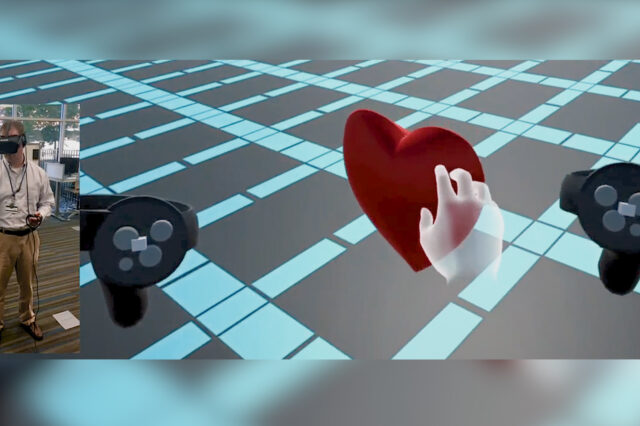UF graduate students develop virtual crash cart to help save lives in an emergency

When a patient’s condition rapidly deteriorates in a hospital or an acute care clinical setting, care providers quickly wheel out a piece of equipment known as a crash cart that contains medications and devices essential for saving a life.
Crash carts are locked until needed, which means that faculty and staff cannot explore them during down times and acquaint themselves with where each item is located. Such unfamiliarity can lead to delays in treatment as providers search for needed items.
A team from the pediatric simulation task force at the UF College of Medicine’s department of pediatrics worked with a group of four University of Florida computer science graduate students to come up with a high-tech solution to this problem. They’ve developed a virtual reality crash cart for pediatric units that is part game and part educational tool.
“In the past, we’ve used a pen-and-paper scavenger hunt to familiarize providers with what is in a crash cart,” said Erik Black, Ph.D., M.P.H., an assistant professor in pediatrics and educational technology at the college. “We wondered if it would be possible to build a virtual one, something that could be a game and could be used to teach more than one time.”
Black and his team of collaborators — Nicole Paradise Black, M.D., M.Ed.; Jennifer Munoz-Pareja, M.D.; and Hillary Rohrs, ARNP — worked for eight weeks with a group of UF computer science graduate students — Mohit Gupta, Jinansh Patel, Anurag Singh and Deepanshu Tyagi — to develop the initial framework for the virtual reality pediatric crash cart.
The cart was the students’ project in the Virtual Reality for the Social Good Initiative, a UF course that launched in 2016 for anyone interested in solving social problems using virtual technologies. The class is led by Sriram Kalyanaraman, a UF professor of journalism, and Benjamin Lok, a UF professor of computer science.
Using a virtual reality headset and joysticks, the user is put in the shoes of an emergency medical professional who needs to find the correct items from the crash cart in a limited time. Once the session begins, the screen tells the user what item to obtain. The user is tasked with opening the drawers of the cart using the joystick in each hand, picking up the correct item and handing it to a virtual medical professional standing in close vicinity. The timer runs until all items have been found.
“Our focus was on the underlying infrastructure of the product, not on the look and feel,” Black said. “We wanted to make sure that we had something with working game mechanics and physics, knowing that at a later time we could layer on top of it the ‘frosting’ to make it look really sharp.”
At the end of the semester, the students presented their virtual reality crash cart during a demo day, where they competed against more than 30 other teams. Guests voted on each project, and the virtual crash cart topped them all, winning twice as many votes as the second-place team.
“The demo day was a great learning experience for us, by which we learned to inspire people to try something new and make them take a leap into virtual reality by showcasing our project and bringing in a sense of competition and fun,” said Singh. “People loved the idea of how we can train medical professionals to use a virtual crash cart to get the correct medicine or tool as fast as possible to save lives.”
Black noted that in recent years, the need for crash carts has diminished because providers are anticipating and preventing acute care scenarios.
“Not only are providers not accessing the carts as often because they are kept under lock, fortunately, they don’t need to access them as often because patients are not requiring them, which is fantastic,’’ he said. “However, there are unintended consequences, and one of those is familiarity, comfort, and being able to orient oneself quickly to the materials that are inside a cart.”
Even with the exciting finish, Black said this is not the end of the project. His next step will be to show UF physicians and UF Health providers what has been developed and ask for feedback. Based on those comments and suggestions, Black and his pediatric simulation taskforce colleagues will create a list of improvements and pitch the idea again to the VR for the Social Good class in the fall.
“The initial group of students put in the extra time and effort and built a fantastic product,” says Black. “We want to continue to build on the success we’ve already had.”